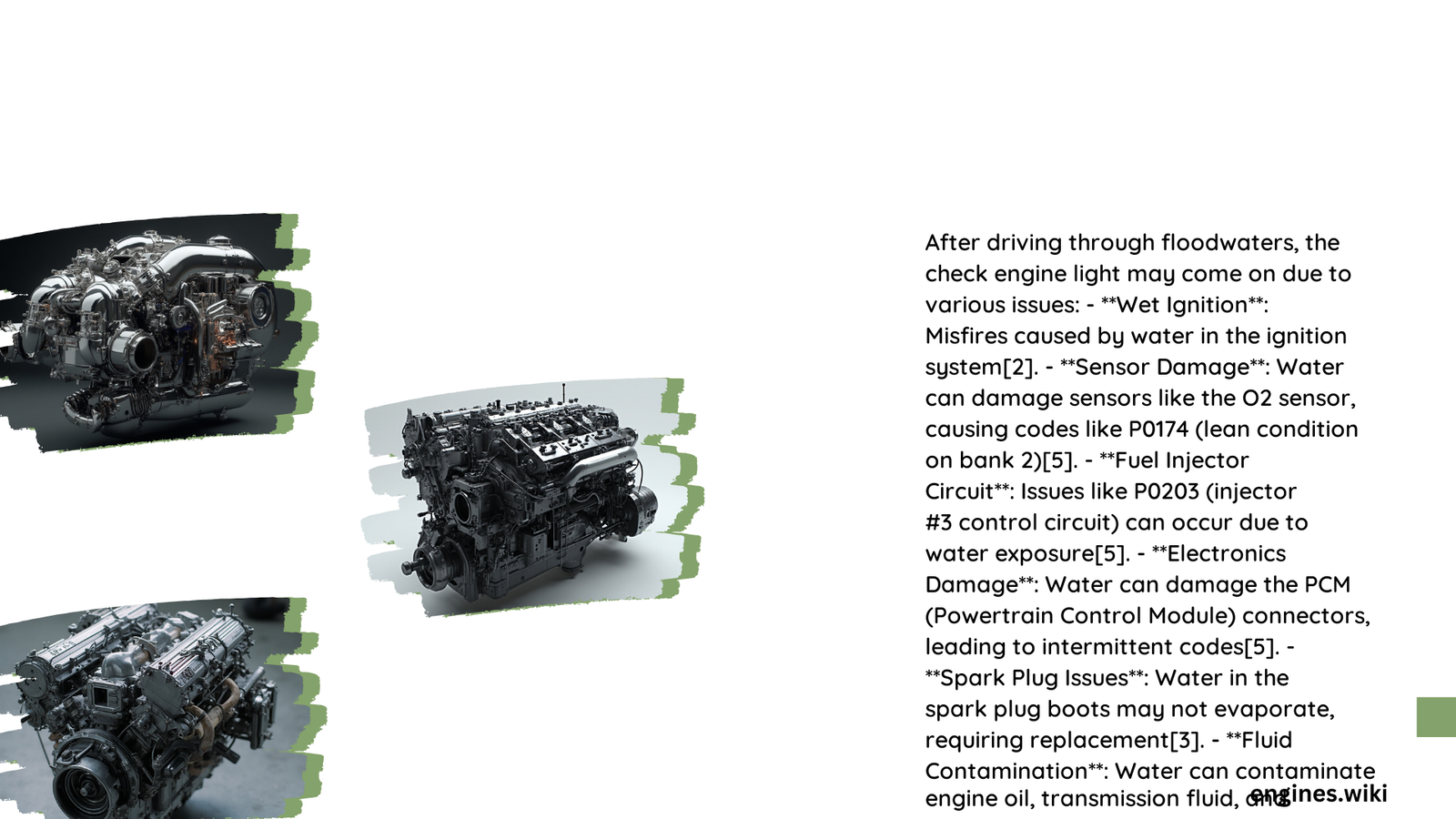When a vehicle experiences flooding, the check engine light often illuminates due to water damage. This comprehensive guide addresses the critical steps for diagnosing and repairing a flooded engine, including common diagnostic codes, repair procedures, and potential challenges. Understanding these aspects is crucial for effectively addressing engine issues after a flood and potentially saving your vehicle from irreparable damage.
What Are the Common Diagnostic Codes After a Flood?
Flood damage can trigger various diagnostic trouble codes (DTCs) in a vehicle’s engine control module. Here are some of the most common codes you might encounter:
- Misfire Codes (P0300-P0308): Indicate cylinder misfires due to water contamination in the ignition system.
- Fuel Trim Codes (P0171, P0174): Suggest issues with the fuel-air mixture, often caused by water in the fuel system.
- Oxygen Sensor Codes (P0130-P0134): Signal problems with oxygen sensors damaged by water exposure.
- Electrical System Codes (U0100-U0199): Indicate various electrical malfunctions resulting from water damage.
These codes provide valuable insights into the specific areas of the engine affected by flooding.
How to Assess and Repair a Flooded Engine?

Addressing a flooded engine requires a systematic approach. Follow these steps for assessment and repair:
- Safety First: Disable the vehicle’s electrical system to prevent further damage.
- Visual Inspection: Look for visible signs of water damage, including:
- Waterlines on engine components
- Rust and corrosion
- Debris accumulation
- Diagnostic Scan: Use an OBD-II scanner to retrieve DTCs and analyze live data.
- Drain and Clean: Remove standing water and clean affected components.
- Component Replacement: Replace submerged electrical parts, especially if exposed to salt water.
- Fluid Check: Inspect and replace contaminated fluids (engine oil, transmission fluid, fuel).
- Air System Inspection: Check and replace damaged air filters and compressors.
- Brake System Evaluation: Inspect and repair damaged ABS components.
What Are the Costs and Timeframes for Flood Damage Repair?
The extent of flood damage significantly impacts repair costs and duration:
| Damage Level | Estimated Cost | Repair Time |
|---|---|---|
| Minor | $500 – $3,000 | 1-5 days |
| Moderate | $3,000 – $8,000 | 1-2 weeks |
| Severe | $8,000+ | 2+ weeks |
| Total Loss | N/A | N/A |
Note: These are general estimates and can vary based on vehicle make, model, and specific damage.
What Challenges Arise During Flooded Engine Repairs?
Repairing a flooded engine presents several unique challenges:
- Component Accessibility: Reaching certain parts may require extensive disassembly.
- Specialized Tools: Diagnostic equipment like scan tools and multimeters are essential.
- Corrosion Effects: Long-term reliability issues due to rust and corrosion.
- Hidden Damage: Water can affect components not immediately visible.
What Are the Telltale Symptoms of a Flood-Damaged Engine?
Recognizing flood damage symptoms is crucial for timely intervention:
- Musty odor from interior components
- Visible waterlines on engine parts or lights
- Unusual rust on typically non-rusting components
- Milky appearance in engine oil
- Damaged or waterlogged air filter
- Erratic electrical system behavior
How Does Flood Damage Affect Engine Performance?
Flood damage can lead to various performance issues:
- Engine Misfires: Caused by water in the fuel or ignition system.
- Fuel System Problems: Irregular fuel trim and oxygen sensor readings.
- Transmission Issues: Erratic shifting due to fluid contamination.
- Brake System Malfunctions: ABS failures from water and contaminant exposure.
- Electrical Glitches: Intermittent failures in lights, accessories, or sensors.
Can You Prevent Engine Damage During a Flood?
While it’s challenging to fully protect an engine from flood damage, some preventive measures can help:
- Avoid Deep Water: Don’t drive through flooded areas if possible.
- Elevate the Vehicle: Park on higher ground if flooding is anticipated.
- Use Water-Resistant Covers: Apply waterproof covers to vulnerable components.
- Regular Maintenance: Well-maintained engines may be more resilient to water damage.
What Long-Term Effects Can Flood Damage Have on an Engine?
Even after initial repairs, flood damage can have lasting impacts:
- Accelerated Corrosion: Leading to premature component failure.
- Electrical System Instability: Intermittent issues may persist.
- Reduced Engine Lifespan: Overall longevity of the engine may be compromised.
- Decreased Vehicle Value: Flood history can significantly impact resale value.
When Should You Consider Replacing vs. Repairing a Flood-Damaged Engine?
The decision to replace or repair depends on several factors:
- Extent of Damage: Severe damage often warrants replacement.
- Vehicle Age and Value: Older or less valuable vehicles may not justify extensive repairs.
- Insurance Assessment: Insurance companies may declare the vehicle a total loss.
- Long-Term Reliability Concerns: Consider the potential for ongoing issues.
How to Document Flood Damage for Insurance Claims?
Proper documentation is crucial for insurance claims:
- Photograph Everything: Take detailed pictures of all visible damage.
- Keep All Receipts: Document all repair-related expenses.
- Obtain Professional Assessments: Get written evaluations from certified mechanics.
- Preserve Damaged Parts: Keep replaced components as evidence if required.
By following this comprehensive guide, you can effectively address the check engine light issues after a flood and make informed decisions about your vehicle’s repair or replacement. Remember, professional assistance is often necessary for dealing with extensive flood damage to ensure safety and proper restoration of your vehicle’s functionality.
References:
1. Toyota Motor Sales, USA – Flood Damaged Vehicle Inspection and Handling
2. Consumer Reports – Beware a Flood of Flooded Cars
3. Fleet Maintenance – How to Effectively Inspect and Repair Flood-Damaged Vehicles
